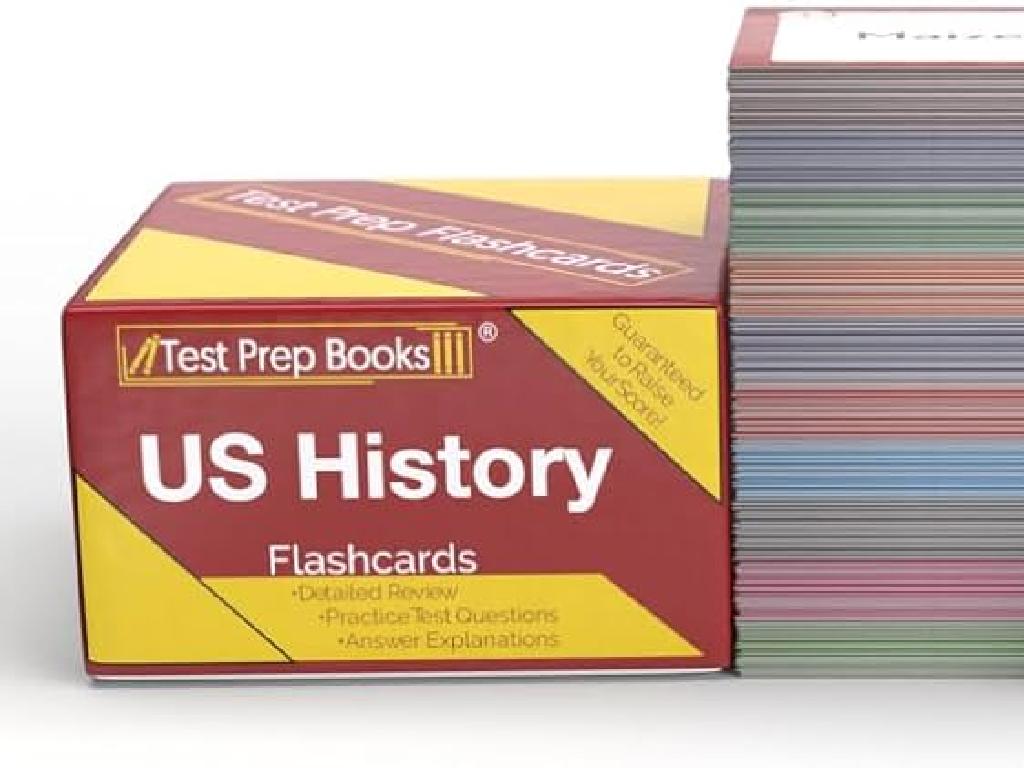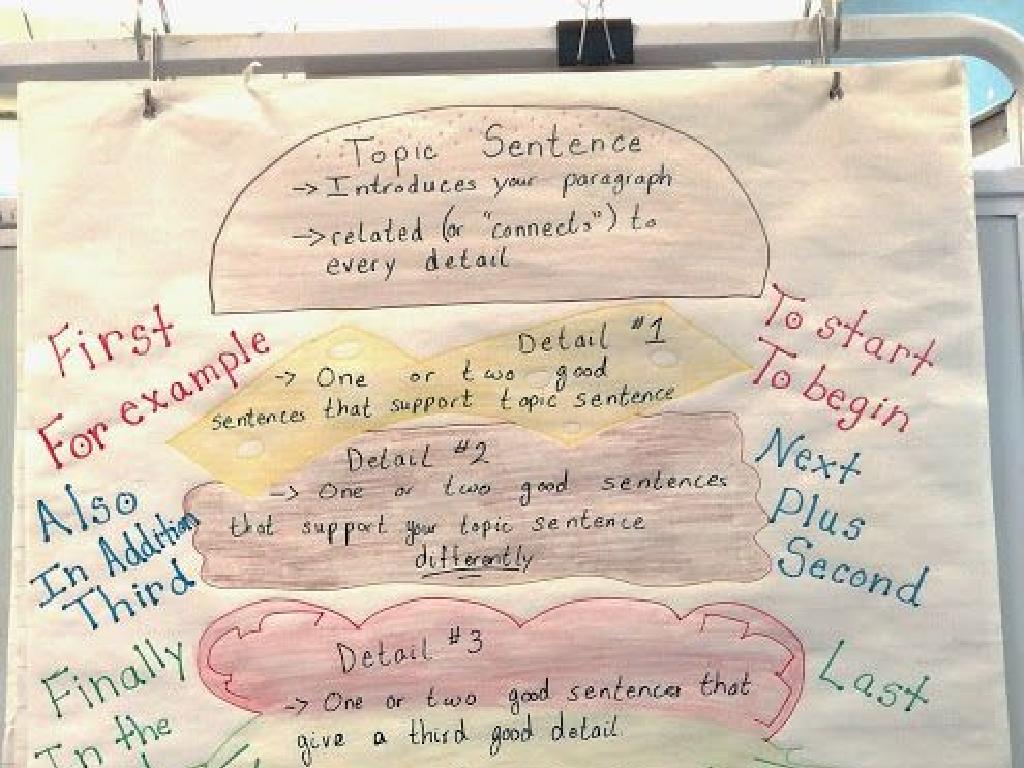Abbreviate Days Of The Week
Subject: Language arts
Grade: Fourth grade
Topic: Abbreviations
Please LOG IN to download the presentation. Access is available to registered users only.
View More Content
Abbreviating Days of the Week
– What are abbreviations?
Shortened forms of words or phrases.
– Why use abbreviations?
For quicker writing and to save space.
– Days of the week shortened
Sun., Mon., Tue., Wed., Thu., Fri., Sat.
– Practice with examples
Let’s write the days in your journal!
|
Begin the lesson by explaining that an abbreviation is a shortened form of a word or phrase, used to save time and space in writing. Discuss why abbreviations are useful, especially when taking notes or writing in a calendar. Introduce the abbreviations for the days of the week, ensuring to point out any patterns, like ‘n.’ for ‘day.’ Engage the class by having them practice writing the abbreviations for each day, perhaps in their journals or on a worksheet. This will help solidify their understanding and give them a practical application of the lesson.
Exploring Abbreviations
– What’s an abbreviation?
– A shortened form of a word or phrase
– Common abbreviation examples
– e.g., Dr. for Doctor, Jan. for January
– Abbreviations vs. Acronyms
– Abbreviations are shortened forms, acronyms form new words
– Practice with days of the week
– Mon. for Monday, Tue. for Tuesday, etc.
|
Begin by explaining that an abbreviation is a way to shorten words to make writing and speaking quicker and more efficient. Provide familiar examples that the students may encounter in their daily lives, such as abbreviations for titles or months. Clarify the difference between abbreviations and acronyms, noting that acronyms form new words from the first letters of a series of words, like NASA or SCUBA, while abbreviations are just a shortened form of a single word. Engage the class by practicing abbreviating the days of the week, ensuring they understand that each day can be shortened to a three-letter abbreviation, which is commonly used in calendars and schedules.
Abbreviating Days of the Week
– List all days in a week
– Sunday, Monday, Tuesday, Wednesday, Thursday, Friday, Saturday
– Why abbreviate days?
– Saves time & space in writing
– Where are abbreviations used?
– Calendars, planners, notes
– Practice abbreviating
– Let’s try shortening each day together!
|
This slide introduces the concept of abbreviating the days of the week. Start by listing all seven days to familiarize the students with the full names. Discuss the practical reasons for abbreviating, such as saving time and space, especially in written communication. Provide examples of where abbreviations are commonly used, like in calendars or personal planners. Engage the class in an activity where they practice writing the abbreviations for each day. For instance, ‘Sun.’ for Sunday, ‘Mon.’ for Monday, and so on. This will help them remember the abbreviations and understand their usage in everyday life. Encourage students to think of other situations where they might need to use these abbreviations.
Abbreviating Days of the Week
– How to abbreviate each day
– Use the first three letters: Mon, Tue, Wed, etc.
– Rules for abbreviating days
– Capitalize the first letter, end with a period if alone.
– Practice abbreviating together
– We’ll abbreviate days as a class activity.
|
This slide introduces students to the concept of abbreviating days of the week, which is a common practice in writing. Start by explaining that each day of the week can be shortened to its first three letters, and these abbreviations are often used in calendars and schedules. Emphasize the importance of capitalizing the first letter of each abbreviation and using a period if the abbreviation stands alone. Engage the class in a collaborative activity where they practice writing out the abbreviations together. This will help reinforce the rules and ensure that students feel comfortable using these abbreviations in their writing.
Abbreviating Days of the Week
– Examples in sentences
– Mon. stands for Monday, as in ‘See you on Mon.!’
– Group activity: Matching days
– Match ‘Tuesday’ with ‘Tue.’ and ‘Friday’ with ‘Fri.’
– Individual practice: Write sentences
– Use ‘Wed.’ in a sentence, like ‘I have art class on Wed.’
– Understanding abbreviations
|
This slide is aimed at helping students understand and practice abbreviating the days of the week. Start by showing examples of each abbreviated day within the context of a sentence to illustrate proper usage. For the group activity, provide cards with days and their abbreviations for students to match, fostering teamwork and reinforcing learning. Then, have each student individually write sentences using abbreviated days to ensure personal understanding. Emphasize that abbreviations are a convenient way to write dates in a shorter form and are commonly used in calendars and planners. Encourage creativity in sentence formation and correct any misunderstandings during the activities.
Class Activity: Weekly Calendar Creation
– Create your own weekly calendar
– Use a blank calendar template and fill in your activities
– Use abbreviations for each day
– Remember: Mon., Tue., Wed., Thu., Fri., Sat., Sun.
– Share your calendar with the class
– Present your calendar to the class and explain your week
|
This activity is designed to help students practice abbreviating days of the week while engaging in a creative task. Provide each student with a blank calendar template. Guide them to fill in their weekly activities using the correct abbreviations for the days of the week. Once completed, students will share their calendars with the class, explaining their activities for each day. This will reinforce their understanding of abbreviations and give them an opportunity to practice speaking in front of the group. Possible variations of the activity could include pairing students to discuss their calendars, creating digital calendars, or even designing a themed week around a holiday or event.
Abbreviations Review & Quiz
– Recap days of the week abbreviations
– Remember: Mon., Tue., Wed., Thu., Fri., Sat., Sun.
– Pop Quiz: Abbreviation fill-in-the-blanks
– Use your abbreviation knowledge to complete the quiz
– Review quiz answers together
– We’ll go over the answers as a class and learn from mistakes
– Reinforce abbreviation rules
|
Begin with a quick review of the abbreviations for the days of the week, ensuring that students recall the correct format for each day. Move on to a pop quiz where students will fill in the blanks with the correct abbreviations. This activity will help assess their understanding and retention of the material. After the quiz, discuss the answers as a class to provide immediate feedback and reinforce learning. Emphasize the importance of using correct punctuation and capitalization in abbreviations. Encourage students to ask questions if they’re unsure about any of the answers, fostering a collaborative learning environment.
Wrapping Up: Days of the Week Abbreviations
– Recap abbreviating days
– Remember: Mon., Tue., Wed., Thu., Fri., Sat., Sun.
– Why practice abbreviations?
– Helps with note-taking & organization
– Homework: Diary with abbreviations
– Use each day’s abbreviation in an entry
|
As we conclude, remind students of the abbreviations for each day of the week. Emphasize the importance of practicing abbreviations to become more efficient in writing and organizing information. For homework, students will write a diary entry for the week, using the correct abbreviation for each day. This will help reinforce their learning and provide practical application. Encourage creativity and personal expression in their diary entries. During the next class, consider allowing a few students to share their diary entries to demonstrate understanding and celebrate their work.






